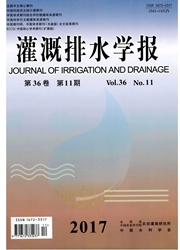

 中文摘要:
中文摘要:
用关中地区30个气象站41年气象资料,探讨了关中地区主要作物冬小麦和夏玉米需水量与相应生育期内气候因子的变化趋势,分析了气候变化对作物需水量的影响。结果表明:关中地区冬小麦需水量无一致变化趋势,净灌溉需水量(NIWR)呈增加趋势;夏玉米需水量呈不显著减少趋势,净灌溉需水量无一致变化趋势。气象因子影响顺序为,冬小麦:相对湿度〉最高气温〉日照时数〉降水量〉平均气温〉风速,夏玉米:日照时数〉相对湿度〉最高气温〉平均气温〉降水量〉风速。日照时数和风速引起冬小麦需水量的降低趋势在很大程度上抵消了相对湿度和最高气温引起的冬小麦需水量的升高趋势,而冬小麦生育期降水的减少是造成冬小麦净灌溉需水量增加的主要原因;风速和日照时数的降低趋势是导致夏玉米需水量减少的主要原因。关中地区秋冬春季向暖干发展,夏季除风速显著降低外,其它气象因子变化不大。
 英文摘要:
英文摘要:
The trend of water requirements of winter wheat and summer maize and weather factors in their growing season is discussed, and effect of climate change on ETε is analyzed according to weather data of 41 years for 30 weather stations in Guanzhong Region. The results show that there is no consistent tendency on ETc and increase on net irrigation water requirement(NIWR) for winter wheat, and no significant decrease on ETε and no consistent tendency on NIWR for summer maize. The influence capacity of weather factors on ETc is as follow: for winter wheat relative humidity〉maximum temperature〉sunlight hours〉 precipitation〉mean temperature〉wind speed, and for summer maize sunlight hours〉relative humidity〉 maximum temperature〉mean temperature〉precipitation〉wind speed. The decline of winter wheat ET, caused by sunlight and wind speed offsets the its increase resulted from relative humidity and maximum temperature. The decreasing precipitation is main reason for the increase of winter wheat NIWR, and the decline of sunlight and wind speed is main reason for the decrease of summer maize ETε. The climate is getting warmer and drier in fall, winter and spring.
 同期刊论文项目
同期刊论文项目
 同项目期刊论文
同项目期刊论文
 期刊信息
期刊信息
